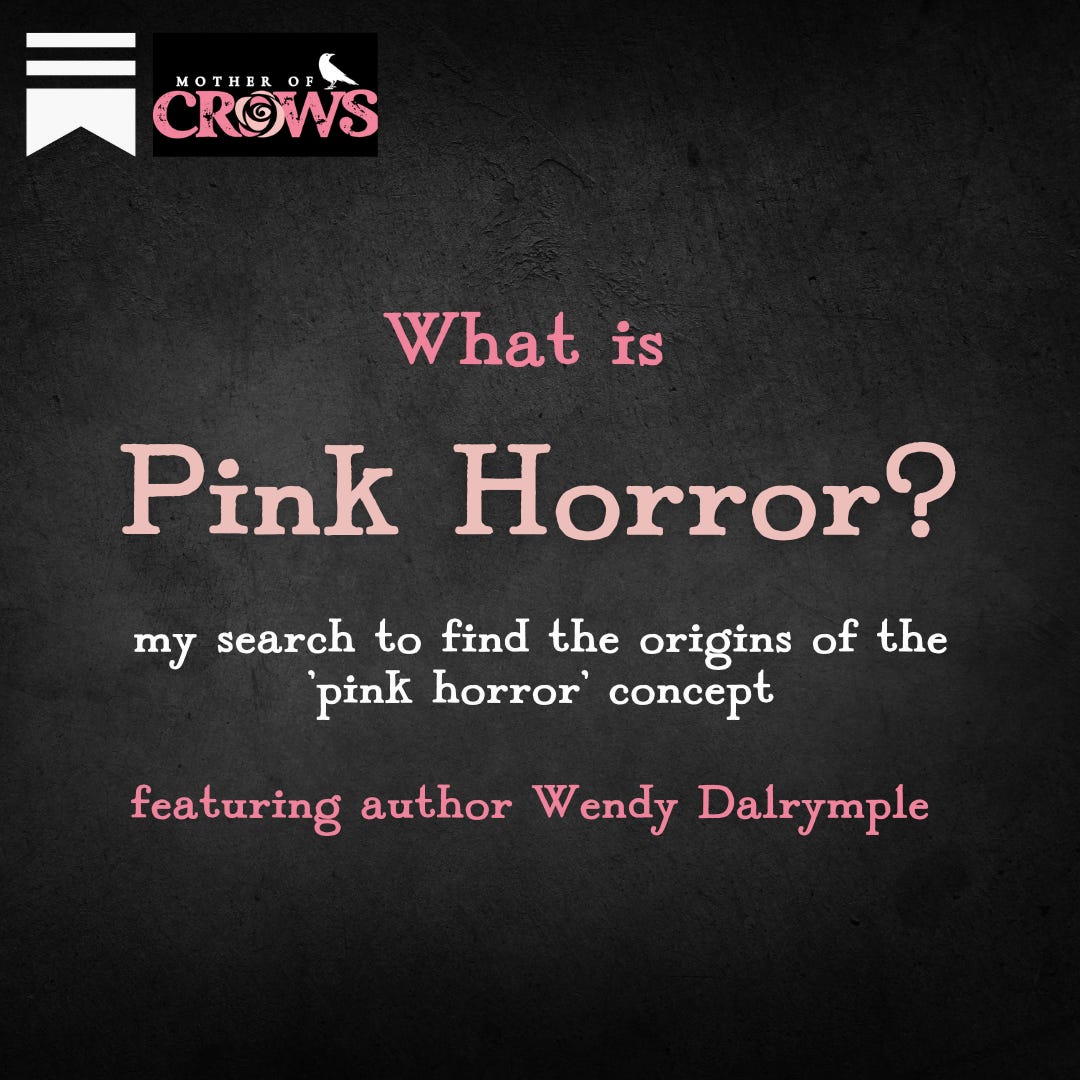I recently released a horror collection with a simple cover of textured black with bright pink lettering. After publishing a long line of elaborate, almost borderline-baroque book covers through Quill & Crow, why would a horror writer obsessed with all things dark, dreary, and macabre make her upcoming short story collection (and other branding) pink?
Well, like everything with me, there is a story behind it.
First, I absolutely love playing with juxtaposition in my artistic endeavors. I do it whenever I can. Fortunately for me, this generation’s trendsetters love them an aesthetic; everything is a ‘-core’ and I’m here for it. So when Barbie-core took over our summer, and I watched it clash with the concurrent release of the grim Oppenheimer, it grabbed my attention. People began pairing my beloved black with bubblegum pink in their videos, memes, and aesthetics. I was over the moon. The sweet pinks mixed with delicious blacks felt like the visual representation of my ‘cupcakes-and-bats’ persona, and I embraced the vibe immediately. As someone who was also embracing her feminine side after years of maintaining a hard-edged persona, it was a perfect fit. So when it came time to quick-release my short horror story collection, I knew it had to be pink.
There were a few reasons behind this. As a publisher, I see covers for what they are: visual marketing. The stories in my collection are eclectic, but they all have one connecting thread: they were all written by a woman who hates the damn patriarchy and loves women and children. The stories are not soft by any stretch of the imagination, but the horror and gore are not exploitative. While my horror can easily be read by anyone, I write with a “female horror gaze.” In my mind, a cold, mysterious black with bright pink text was the perfect way to express this.
As soon as I dropped it, another woman horror writer, my friend Mary, sent me a link to a post about ‘pink horror.’ I’d heard the concept mentioned before but had never had time to fully explore what it meant. So, with the release of my collection, I set down to learn more about it.
So, what exactly is pink horror?
The expression is most commonly used when referring to horror movies that liberally use bright colors, including the infamous bubble gum hue, to set the tone. Think The Love Witch (2016), Jawbreaker (1999), or even Suspiria (1977).1
In an article written by Shannon Lewis, “The Meaning of Pink in Horror,” she describes how the color is intentionally used to express girlhood, youth, and femininity. She cites examples from movies such as Candyman and Carrie, asserting that when we see pink in horror, “it tells you something about the protagonist and her relationship to her surroundings…[and] it lets you know that this movie is going to explore women’s relationship with their own femininity, and the relationship between women’s femininity and the world.”
You can read the full article here:
But can’t ‘pink horror’ be applied to horror books too?
Remarkably, my research here came up short. I could not find anything written about ‘pink horror’ as a genre, so I did what any good indie horror writer would do: I messaged Mother Horror herself, Sadie Hartmann. She told me she’d heard of it but wasn’t sure exactly where she first heard it from; she wondered if she’d gotten the idea from seeing the niche whimsy-goth aesthetic. In fact, she thought she’d heard me talk about it, and if so, she let me know in her blunt-but-funny Sadie way that if it’s not already a thing, I should make it one. And honestly, who could argue with that? I have no issue with ‘trying to make fetch happen.’ But it still begged the question: where did we both hear it from?
Suddenly, I remembered the Instagram post Mary had sent me when I released the book cover. I traced it back to the wonderful Wendy Dalrymple, an author who, remarkably enough, just did a talk on ‘pink horror’ at a writer’s event called Halloween Hangover. At last, I had answers. She was gracious enough to let me pick her brain, which I have compiled below:
Impromptu Interview w/ Wendy Dalrymple
MoC: I’ve only seen ‘pink horror’ when describing horror films, but recently, I’ve heard it used to describe a concept beyond an aesthetic. Had you heard of ‘pink horror’ to describe horror books before, or is it something you developed on your own?
Wendy: I honestly don’t know where ‘pink horror’ came from, but I recall hearing it first from Sadie Hartmann (Mother Horror). She created a post on the topic featuring horror books with pink covers that had strong femme leads, and it resonated with me instantly.
MoC: Tell us what ‘pink horror’ means to you.
Wendy: To me, pink horror is femme-forward, feminist, queer, anti-misogyny, anti-misandry, anti-racist and inclusive. Pink horror centers on unlikeable female or femme-presenting main characters who encounter monsters that mirror the real-life horrors that we all face. Pink horror can be symbolic of the abusive partner who shares your bed, the unsympathetic doctor who doesn’t listen to your health concerns or the government official who makes choices about your body for you.
MoC: Do you think there are similarities between ‘pink horror’ and Gothic horror?
Wendy: Definitely. Charlotte Perkins Gilman’s ‘The Yellow Wallpaper’ is a prime example of pink horror (even though it's yellow!). The main character of this story is driven mad due to a Victorian-era “cure” and highlights many of the same issues women still face today when it comes to being believed about their mental health issues.
Often in gothic horror, our heroines are brutalized, gaslit, and ultimately stripped of their autonomy, as the main character Nomi is in Silvia Morneo-Garcia’s ‘Mexican Gothic.’ Gothic heroines shine a lantern on the fact that some paranormal horror pales in comparison to the real-life horrors set up on them by their abusers. When our gothic heroines rise above these horrors and escape their captors, we too, can see a light at the end of our dark tunnels.
MoC: How do you incorporate ‘pink horror’ in your novels?
Wendy: Psychological horror and body horror are almost always at play in my work, which are two key tenets of pink horror. For me, there is no greater personal horror than losing the autonomy of one’s self, whether through paranormal transformation or being drugged by someone you thought was a friend.
I also tend to lean heavily into femme themes in my work, like in my novella ‘Don’t Read This or You Might Die.’ Readers have called that one ‘The Devil Wears Prada’ meets ‘Mean Girls.’ My themes, characters, and content are all unapologetically feminine in the best and brightest way. Let’s just say if you turned your nose up at what the Barbie movie stands for, then my books aren’t for you (wink emoji, lol).
MoC: Do you think ‘pink horror’ is a concept that should be developed more as a genre? Do you think anyone can write ‘pink horror’?
Wendy: I think ‘pink horror’ is already developed, it’s just up to readers or authors to decide whether or not to identify with it. Mona Awad’s ‘Bunny,’ V. Castro’s ‘Queen of Filth,’ and Rachel Harrison’s ‘Such Sharp Teeth’ are just a few obvious contenders for this category. I don’t see pink horror going anywhere but up!
As I recently discussed with a few other authors in a pink horror panel at the Halloween Hangover event, it’s understandable for some to be hesitant about using this term. Books written by women often are dismissed as “women’s fiction” and putting a pink label on top of it may be a double-edged sword. For me, I want to whole-heartedly lean into my femme-ness and pinkness.
As for who can write pink horror, I would also be hesitant to say. While I think that this sub-genre naturally leans toward the femme, this is also a space that I would like to be considered all-inclusive, a place where anyone could tread to explore what ‘pink’ means to them regardless of gender. I would say though, that, pink horror or not, any author writing outside of their lived experience should be prepared to face questions from readers about their intentions.
Reading through her responses, I understood the reason why I love the pink horror concept—it ties to my beloved Gothic genre in the best way.
In fact, could it be a subgenre of Gothic horror itself?
I’m going to continue my quest to find the origins of ‘pink horror,’ but in the meantime, do check out some of Wendy’s recommendations because I certainly will be. I’m also excited to try my hand at writing some ‘pink horror’ myself, and I would encourage anyone else who is interested to do the same. In other words, let’s make ‘fetch’ happen.
This experience has also offered me such a delightful commentary on the indie writing/bookish community—we really do set our own rules and define our own concepts authentically. While none of us knew where the idea came from, it exists, and as women creatives, we can take it and build from there. The possibilities are endless.
If you want to check out my new collection, you can grab it here:
And if you have any insight on ‘pink horror’ or other recommendations, please feel free to drop me a comment. And be sure to follow Wendy on her socials!
Wendy Dalrymple is a horror and romance author based in Tampa Bay, Florida. She writes Florida Gothic horror featuring unlikeable women placed in unusual situations. If you’re interested in reading one of her works featuring pink horror, she suggests ‘Roser Park,’ a modern gothic horror novella about a young woman who takes a house-sitting gig and gets more than she bargains for.
In my research, I found others who claimed ‘pink’ referred to more sexually exploitative films, but I haven’t found much evidence to support that. Maybe that’s a good thing!






Love it. I immediately thought of that Spiderman meme where there are like three Spidermans standing around each pointing at the other one. You point to me, I point to you, Wendy points back to me hahah. In any case, this was an insightful, fabulous article and I'm excited that fetch happened, is happening and will continue to become more fetching.
First time hearing 'pink horror' & definitely a fan of work that falls inside this niche, as a reader & writer.